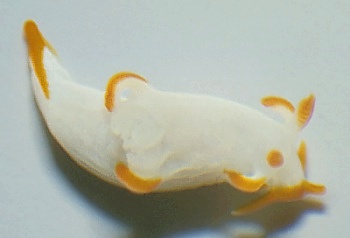
Trapania aurata
Rudman, 1987
Order: NUDIBRANCHIA
Suborder: DORIDINA
Family: Goniodorididae
DISTRIBUTION
Known from Hong Kong, New Caledonia and possibly northwestern Australia.
PHOTO
Upper photo: AM C140174, Holotype. 24 July 1983, Site 11.87, South Ninepin (SE), 14 m, Hong Kong. Photo: Brian Darvell. Lower photos: showing animals from Koumac, New Caledonia, October 1993 AM C200510. Photos: Bill Rudman
I am not sure why this species was aggregated on the aplysillid sponge. Goniodorids are usually found feeding on bryozoans or ascidians. Perhaps there is some animals associated with the sponge that they feed on.
This species is characterised by the yellow-orange tips to the anterior foot "tentacles", the oral tentacles and the rhinophores, and to the orange-yellow line along the dorsal edge of the lateral processes and the dorsal posterior midline of the body. The gills are sometimes lined with the same colour. The original material from Hong Kong had an orange-yellow band across the anterior edge of the head, while New Caledonian animals did not. The radular morphology of the two is not distinctly different.
Photos I have seen of a similar animal with orange markings from Western Australia may be the same species. See Trapania cf. aurata for animals with slightly different colour pattern, which may or may not be variants of this species. See also discussion [#21438 ] concerning the similarly coloured T. vitta, and message #9599 concerning Trapania sp. 8.
-
Rudman,W.B.(1987). The genus Trapania (Nudibranchia: Goniodorididae) in the Indo-West Pacific. Journal of Molluscan Studies, 53: 189-212.
-
Rudman, W.B. & Darvell, B.W. (1990) Opisthobranch Molluscs of Hong Kong: Part 1. Goniodorididae, Onchidorididae, Triophidae, Gymnodorididae, Chromodorididae (Nudibranchia). Asian Marine Biology, 7: 31-79.
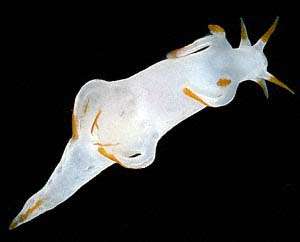
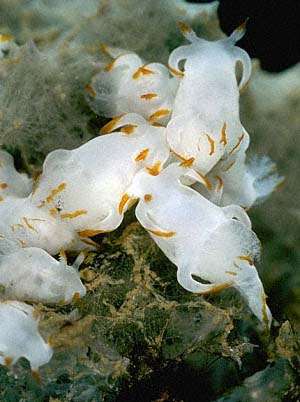
Rudman, W.B., 1998 (November 17) Trapania aurata Rudman, 1987. [In] Sea Slug Forum. Australian Museum, Sydney. Available from http://www.seaslugforum.net/find/trapaura
Related messages
Trapania aurata and T. vitta
March 13, 2008
From: Bill Rudman
Amongst the species of Trapania posted yesterday [message #21446] the one I have most difficulty with is Trapania vitta. That is not to say it will not turn out to be valid species when we know more about it, but at present I have difficulty distinguishing it from T. aurata.
T. vitta is described as having a white body, including white tentacular anterior foot corners and white dorso-lateral processes. The oral tentacles have a white base but are primarily orange, the gills are white with orange edging on the dorsal side, and the rhinophore clubs are similarly white with orange at the tip and down the dorsal surface. The posterior tip of the foot is described as having "an occasional orange pigment spot".
T. aurata was described on the basis of a specimen from Hong Kong with a similar colour pattern. The main points of difference are that it had a orange-yellow band across the front of the head from the base of each orange-yellow oral tentacle, it had orange-yellow lines along the extra-branchial and extra-rhinophoral processes, and it had a distinct orange-yellow line at the posterior tip of the foot.
Gosliner & Fahey describe the radular morphology of T. vitta as closely resembling that of T. aurata Rudman, 1987 from Hong Kong "but the outermost denticle of T. aurata is longer with a base that extends the entire width of the tooth ". I don't know what they mean by that, as when I compare SEM photos of T. aurata from both Hong Kong [message #21436] and New Caledonia [message #21437 ] I can see no real difference.
While the colour differences of the type specimens of these two species may seem quite distinct, every specimen found since then seems to be slightly 'intermediate' in colour pattern. For example I found a number of specimens in New Caledonia [see Fact Sheet and message #3774] which seem to match the colour of the Hong Kong specimen except for the absence of the yellow band on the head. Most sepecimens had the orange edging on the gills but at least two did not. As I mention above I could find nothing in the radular morphology to separate Hong Kong and New Caledonian animals.
Of other animals on the Forum, there are a pair from Bali [#313] which match the description of T. vitta except they have distinct orange line on the posterior tip of the foot like T. aurata. Another pair from East Timor [#17725] also look like T. vitta, but they also have the orange mark on the posterior foot, and one has orange on the anterior foot corners as well, which is another feature of T. aurata.
I dont think there is a simple answer to this but I think we should be alert to the possibility that these are all just one variable species. Unfortunately species of Trapania are often found as single animals rather than large populations, so looking for colour variation in a single population is not easy. It would be valuable if any time a group of Trapania are seen together the finder could take a few photos of groups of animals so we can look for the type of subtle variability I have discussed here.
-
Gosliner, T.M. & Fahey, S.H. (2008) Systematics of Trapania (Mollusca: Nudibranchia: Goniodorididae) with descriptions of 16 new species Systematics and Biodiversity, 6 (1): 53-98
Best wishes
Bill Rudman
Radula of Trapania aurata from New Caledonia
March 12, 2008
From: Bill Rudman
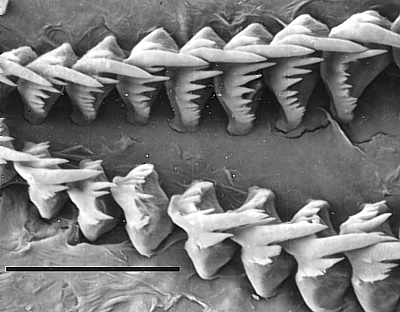
To complement today's posting of many new species of Trapania here is an SEM photo showing aspects of the morphology of the radula of Trapania aurata from New Caledonia.
SEM photos showing irregularities in the left teeth of an animal from New Caledonia. Koumac, New Caledonia, October 1993, AM C200510. SEM Photos: G. Avern. Scale = 50 µm.
-
Rudman, W.B. (1987) The genus Trapania (Nudibranchia: Goniodorididae) in the Indo-West Pacific. Journal of Molluscan Studies, 53: 189-212.
Best wishes
Bill Rudman
Radula of Trapania aurata from Hong Kong
March 12, 2008
From: Bill Rudman
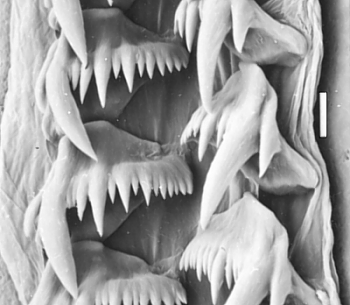
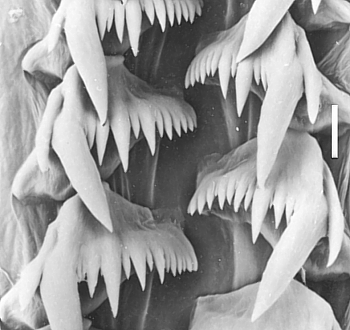
To complement today's posting of many new species of Trapania here are some SEM photos showing aspects of the morphology of the radula of Trapania aurata from Hong Kong.
SEM photos showing sections of the radular ribbon of the holotype. AM C140174, Holotype. 6 mm long preserved. 24 July 1983, Site 11.87, South Ninepin (SE), 14 m, Hong Kong. SEM Photos: G. Avern. Scale = 10 µm.
-
Rudman, W.B. (1987) The genus Trapania (Nudibranchia: Goniodorididae) in the Indo-West Pacific. Journal of Molluscan Studies, 53: 189-212.
Best wishes
Bill Rudman
Trapania aurata from Hong Kong
February 3, 2002
From: Bill Rudman & Brian Darvell
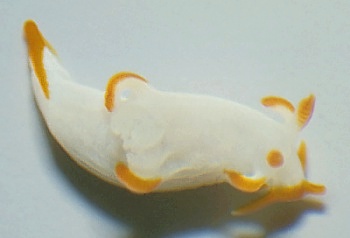
Here is some information and photos on Trapania aurata from Brian Darvell's Hong Kong collections.
The golden yellow markings on this white Trapania easily distinguish it from the other species known from Hong Kong. Each of the known species of Trapania have a precise colour pattern and although there are other white species with yellow markings the arrangement of the yellow is quite different (Rudman 1987a).
The only known specimen is 6 mm long preserved.
PHOTO:
AM C140174, 24 July 1983, Site 11.87, South Ninepin (SE), 14 m, Hong Kong. Photo: Brian Darvell.
Hong Kong Collection Records:
AM C140174, 24 July 1983, Site 11.87, South Ninepin (SE), 14 m, Hong Kong.
Reference:
• Rudman, W.B. & Darvell, B.W. (1990) Opisthobranch molluscs of Hong Kong. Part 1. Goniodorididae, Onchidorididae, Triophidae, Gymnodorididae, Chromodorididae, (Nudibranchia). Asian Marine Biology, 7: 31-79
Best wishes,
Bill Rudman & Brian Darvell
Trapania aurata at Heron Island
February 14, 2001
From: Julie Marshall
Dear Bill,
On looking at your Trapania aurata page I notice that you have the distribution of this species as "known from Hong Kong, New Caledonia and possibly northwestern Australia". This species has also been found at Heron Island [Great Barrier Reef] (Marshall & Willan, 2000). Although I haven't found it myself, Neville Coleman photographed two animals at the Heron Island "Bommie" dive site back in November 1987.
Best wishes,
Julie Marshall
j.marshall@latrobe.edu.au
Marshall, J., 2001 (Feb 14) Trapania aurata at Heron Island. [Message in] Sea Slug Forum. Australian Museum, Sydney. Available from http://www.seaslugforum.net/find/3794Dear Julie
Thanks for the the update. I have to rely on authors and other participants to keep information updated. My page on Trapania aurata predated the publication of your book, where you republish Neville Coleman's Heron Is photo from his 1987 book Nudibranchs of the South Pacific Vol 1.
The animals in Neville's photo are the same as the one from Bali in Michael Miller's earlier message. As I comment in that message, the deep orange colour, rather than golden yellow, and the lack of colour on the lateral processes make me wonder whether this is a distinct species.
I am sure that Trapania aurata has a wide distribution, at least in the western Pacific. However until we can look at its anatomy, I am just a bit unsure that this photo from Heron Is really indicates the presence of T. aurata on the Great Barrier Reef.
Best wishes,
Bill Rudman
Trapania aurata feeding
February 12, 2001
From: Bill Rudman
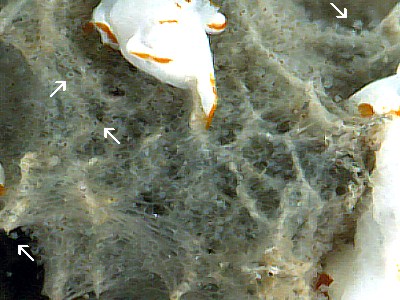
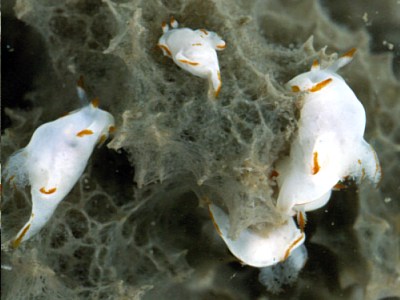
Following Bernard Picton's messages about the food of species of Trapania, I have searched through all my photos trying to find some indication of entoprocts. In these slides of Trapania aurata from Koumac, New Caledonia, clusters of small stalked bodies can be seen in some parts of the sponge on which large numbers of Trapania were clustered. I had a assumed these were reproductive bodies which some sponges produce, but they are probably clusters of entoprocts. Some are stalked and one has a ring of extended tentacles. Unfortunately at this magnification, only a general impression can be seen in the scans.
PHOTOS: Group of Trapania clustered around an aggregation of possible entoprocts on an aplysillid sponge. Koumac, New Caledonia, October 1993. PHOTOS: Bill Rudman
Best wishes,
Bill Rudman
